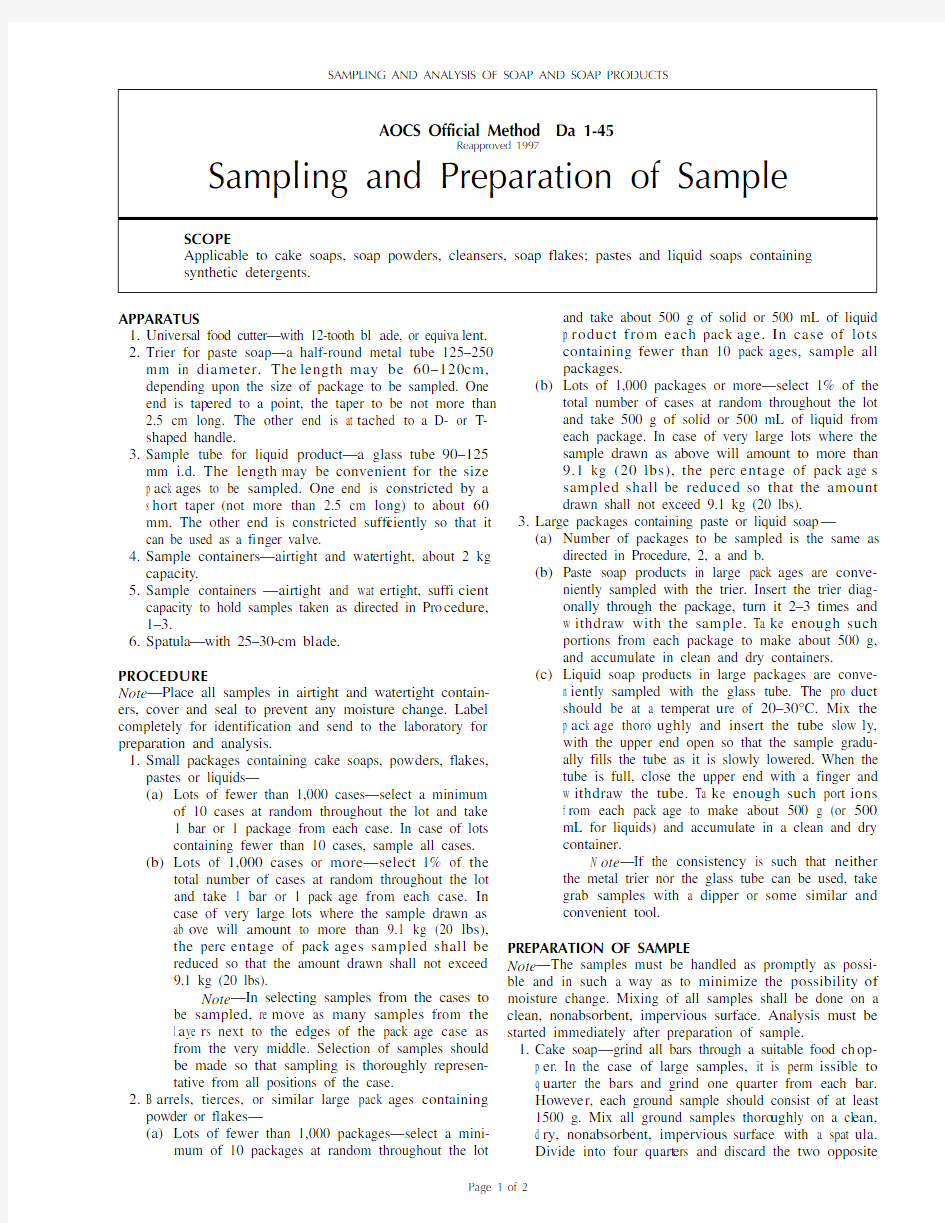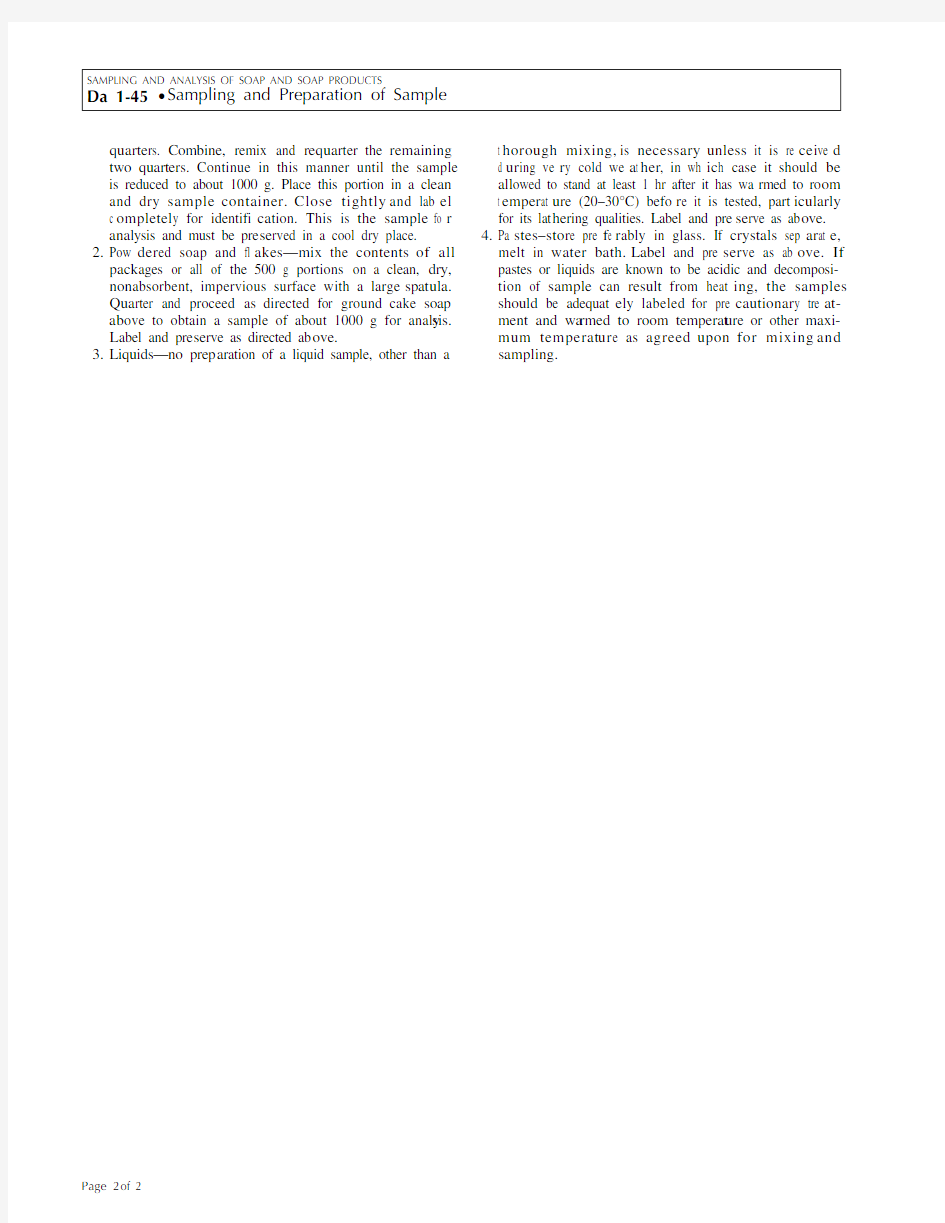da1_45 AOCS


SAMPLING AND ANALYSIS OF SOAP AND SOAP PRODUCTS
AOCS Official Method Da 1-45
Reapproved 1997
Sampling and Preparation of Sample SCOPE
Applicable to cake soaps, soap powders, cleansers, soap flakes; pastes and liquid soaps containing synthetic detergents.
APPARATUS
1.U n ive rsal food cutter—with 12-tooth bl a d e, or equiva l e n t.
2.Trier for paste soap—a half-round metal tube 125–250
mm in diameter. The length may be 60–120 cm,
d epending upon th
e size o
f pack age to be sampled. One
end is tap e red to a point, the taper to be not more than
2.5 cm long. The other end is at t a c hed to a D- or T-
s h aped handle.
3.Sample tube for liquid product—a glass tube 90–125
mm i.d. The length may be convenient for the size p a c k a ges to be sampled. One end is constricted by a s h o r t taper (not more than 2.5 cm long) to about 60 mm. The other end is constricted suffi c i e n t ly so that it can be used as a fi n ger va l ve.
4.Sample containers—a i rtight and wat e rtight, about 2 kg
c ap a c i t y.
5.Sample containers —a i r tight and wat e r tight, suffi c i e n t
c apacity to hol
d samples taken as directed in Pro c
e d u re,
1–3.
6.S p atula—with 25–30-cm bl a d e.
PROCEDURE
Note—Place all samples in airtight and watertight contain-ers, cover and seal to prevent any moisture change. Label completely for identification and send to the laboratory for preparation and analysis.
1.Small pack ages containing cake soaps, pow d e rs, fl a ke s,
pastes or liquids—
(a)Lots of fewer than 1,000 cases—select a minimum
of 10 cases at random throughout the lot and take
1 bar or 1 package from each case. In case of lots
containing fewer than 10 cases, sample all cases.
(b)Lots of 1,000 cases or more—select 1% of the
total number of cases at random throughout the lot
and take 1 bar or 1 pack a ge from each case. In
case of very large lots where the sample drawn as
ab o ve will amount to more than 9.1 kg (20 lbs),
the perc e n t a ge of pack a ges sampled shall be
reduced so that the amount drawn shall not exceed
9.1 kg (20 lbs).
Note—In selecting samples from the cases to be sampled, re m o ve as many samples from the
l a ye r s next to the edges of the pack a ge case as
from the very middle. Selection of samples should
be made so that sampling is thoroughly represen-
tative from all positions of the case.
2.B a r rels, tierces, or similar large pack a ges containing
p owder or fl a ke s—
(a)Lots of fewer than 1,000 packages—select a mini-
mum of 10 packages at random throughout the lot
and take about 500 g of solid or 500 mL of liquid
p r oduct from each pack a ge. In case of lots
containing fewer than 10 pack a ges, sample all
packages.
(b)Lots of 1,000 packages or more—select 1% of the
total number of cases at random throughout the lot
and take 500 g of solid or 500 mL of liquid from
each package. In case of very large lots where the
sample drawn as above will amount to more than
9.1 kg (20 lbs), the perc e n t a ge of pack a ge s
sampled shall be reduced so that the amount
drawn shall not exceed 9.1 kg (20 lbs).
3.L a rge pack ages containing paste or liquid soap—
(a)Number of packages to be sampled is the same as
directed in Procedure, 2, a and b.
(b)Paste soap products in large pack a ges are conve-
niently sampled with the trier. Insert the trier diag-
onally through the package, turn it 2–3 times and
w i t h d r aw with the sample. Ta k e enough such
portions from each package to make about 500 g,
and accumulate in clean and dry containers.
(c)Liquid soap products in large packages are conve-
n i e n t l y sampled with the glass tube. The pro d u c t
should be at a temperat u r e of 20–30°C. Mix the
p a c k a ge thoro u g h l y and insert the tube slow l y,
with the upper end open so that the sample gradu-
ally fills the tube as it is slowly lowered. When the
tube is full, close the upper end with a finger and
w i t h d r aw the tube. Ta k e enough such port i o n s
f r om each pack a ge to make about 500
g (or 500
mL for liquids) and accumulate in a clean and dry
container.
N o t e—If the consistency is such that neither the metal trier nor the glass tube can be used, take
grab samples with a dipper or some similar and
convenient tool.
PREPARATION OF SAMPLE
Note—The samples must be handled as promptly as possi-ble and in such a way as to minimize the possibility of moisture change. Mixing of all samples shall be done on a clean, nonabsorbent, impervious surface. Analysis must be started immediately after preparation of sample.
1.C a ke soap—grind all bars through a suitable food ch o p-
p e r. In the case of large samples, it is perm i s s i b le to q u a r ter the bars and grind one quarter from each bar.
H oweve r, each ground sample should consist of at least
1500 g. Mix all ground samples thoro u g h ly on a cl e a n,
d r y, nonabsorbent, impervious surfac
e with a spat u l a.
D ivide into four quart e rs and discard the two opposite
Page 1of 2
q u a rt e rs. Combine, remix and re q u a rter the re m a i n i n g t wo quart e rs. Continue in this manner until the sample is reduced to about 1000 g. Place this portion in a cl e a n and dry sample container. Close tightly and lab e l c o m p l e t e l y for identifi c a tion. This is the sample fo r a n a lysis and must be pre s e rved in a cool dry place.
2.Pow d e r ed soap and fl a k es—mix the contents of all p a ck ages or all of the 500 g portions on a clean, dry,n o n absorbent, impervious surface with a large spat u l a .Q u a rter and proceed as directed for ground cake soap ab ove to obtain a sample of about 1000 g for analy s i s .L abel and pre s e rve as directed ab ove.
3.Liquids—no prep a ration of a liquid sample, other than a
t h o r ough mixing, is necessary unless it is re c e i ve d d u r ing ve r y cold we a t h e r , in wh i c h case it should be a l l owed to stand at least 1 hr after it has wa rmed to ro o m t e m p e r at u r e (20–30°C) befo r e it is tested, part i c u l a r ly for its lat h e ring qualities. Label and pre s e rve as ab ove.4.Pa s t e s –s t o r e pre f e r ably in glass. If crystals sep a r at e ,melt in water bath. Label and pre s e r ve as ab o ve. If pastes or liquids are known to be acidic and decomposi-tion of sample can result from heat i n g , the samples should be adequat e l y labeled for pre c a u t i o n a r y tre a t-ment and wa rmed to room temperat u re or other maxi-mum temperat u r e as agreed upon for mixing and s a m p l i n g.
Page 2of 2
SAMPLING AND ANALYSIS OF SOAP AND SOAP PRODUCTS
Da 1-45 ? Sampling and Preparation of Sample
